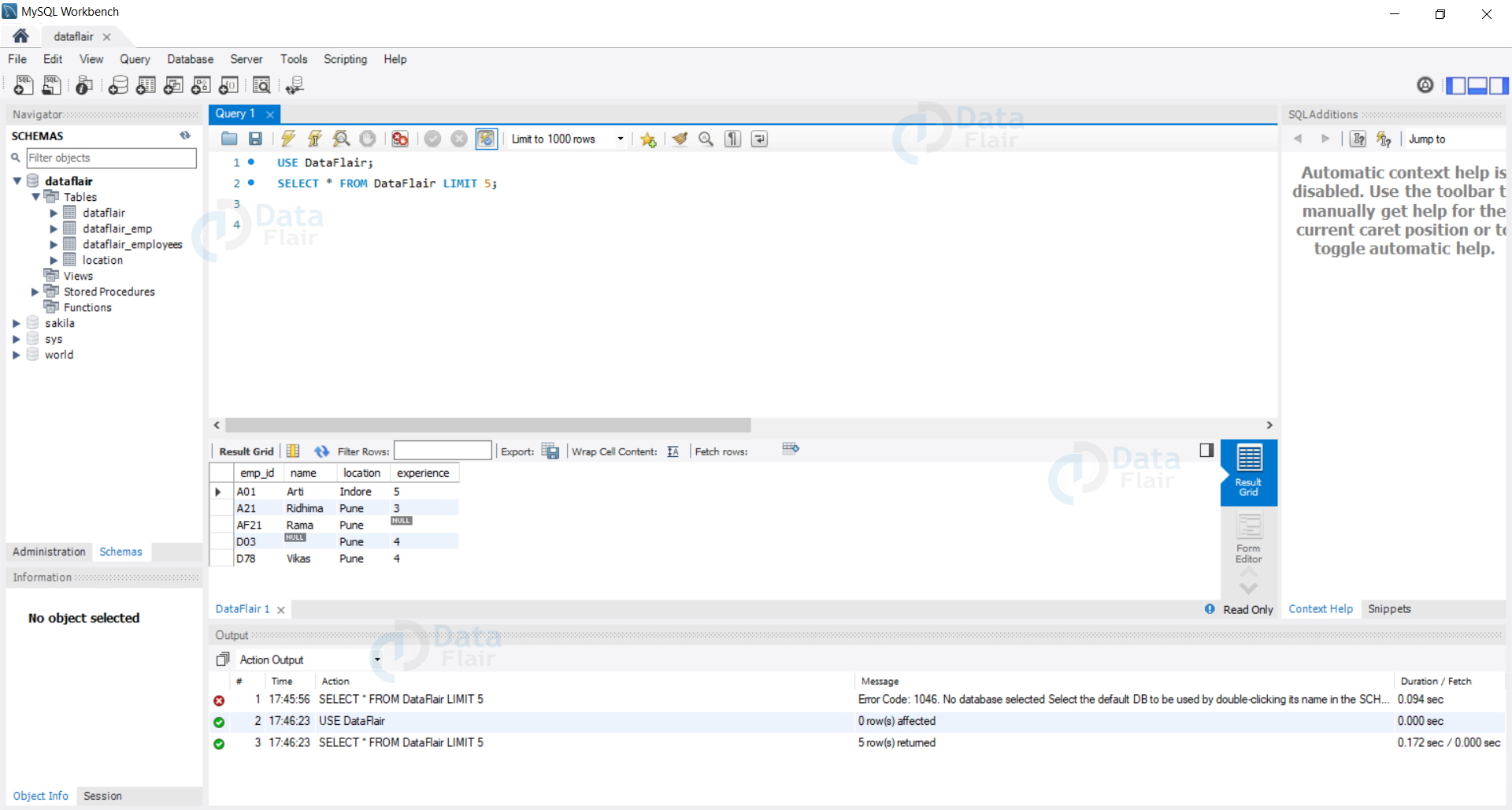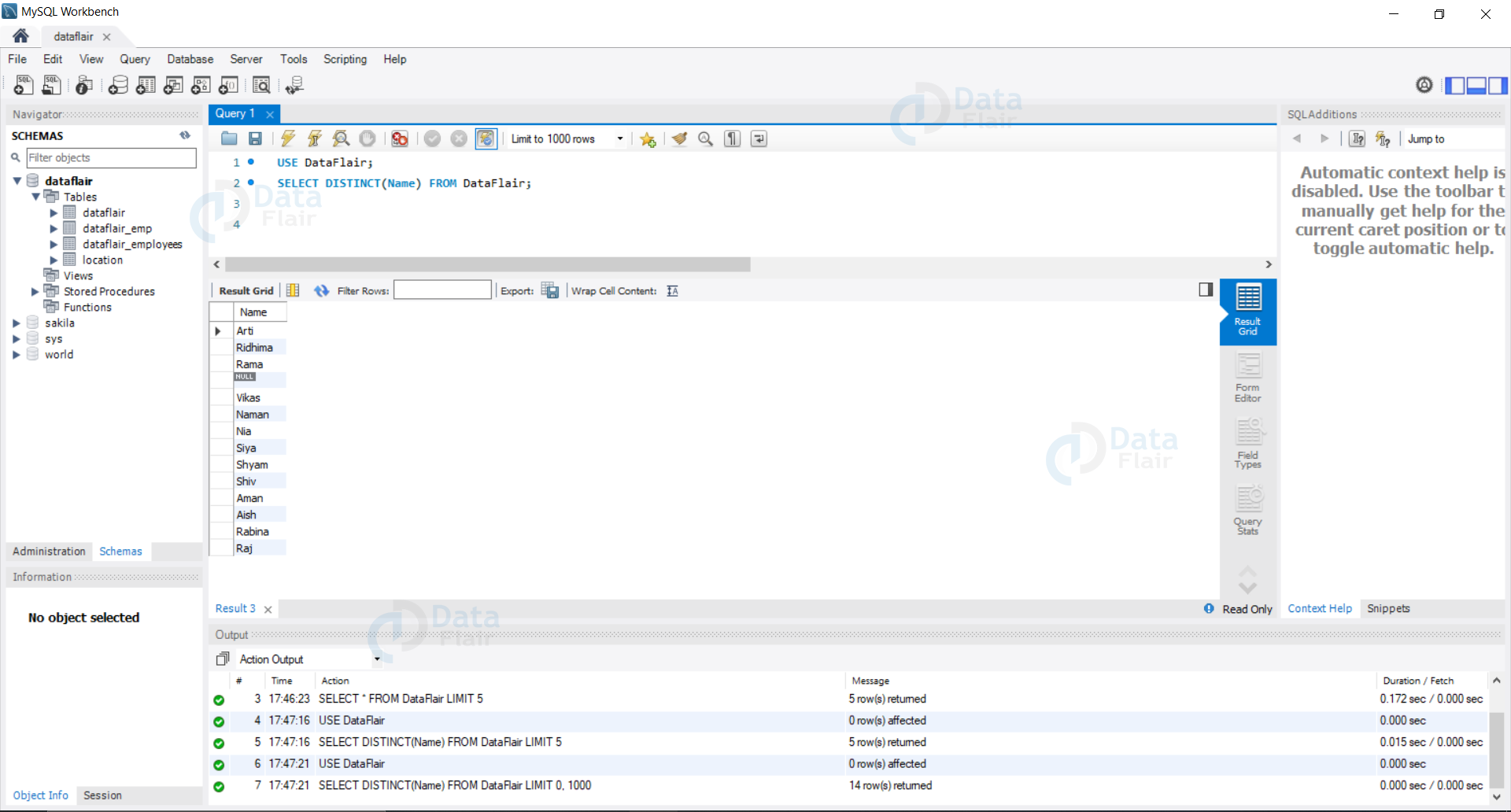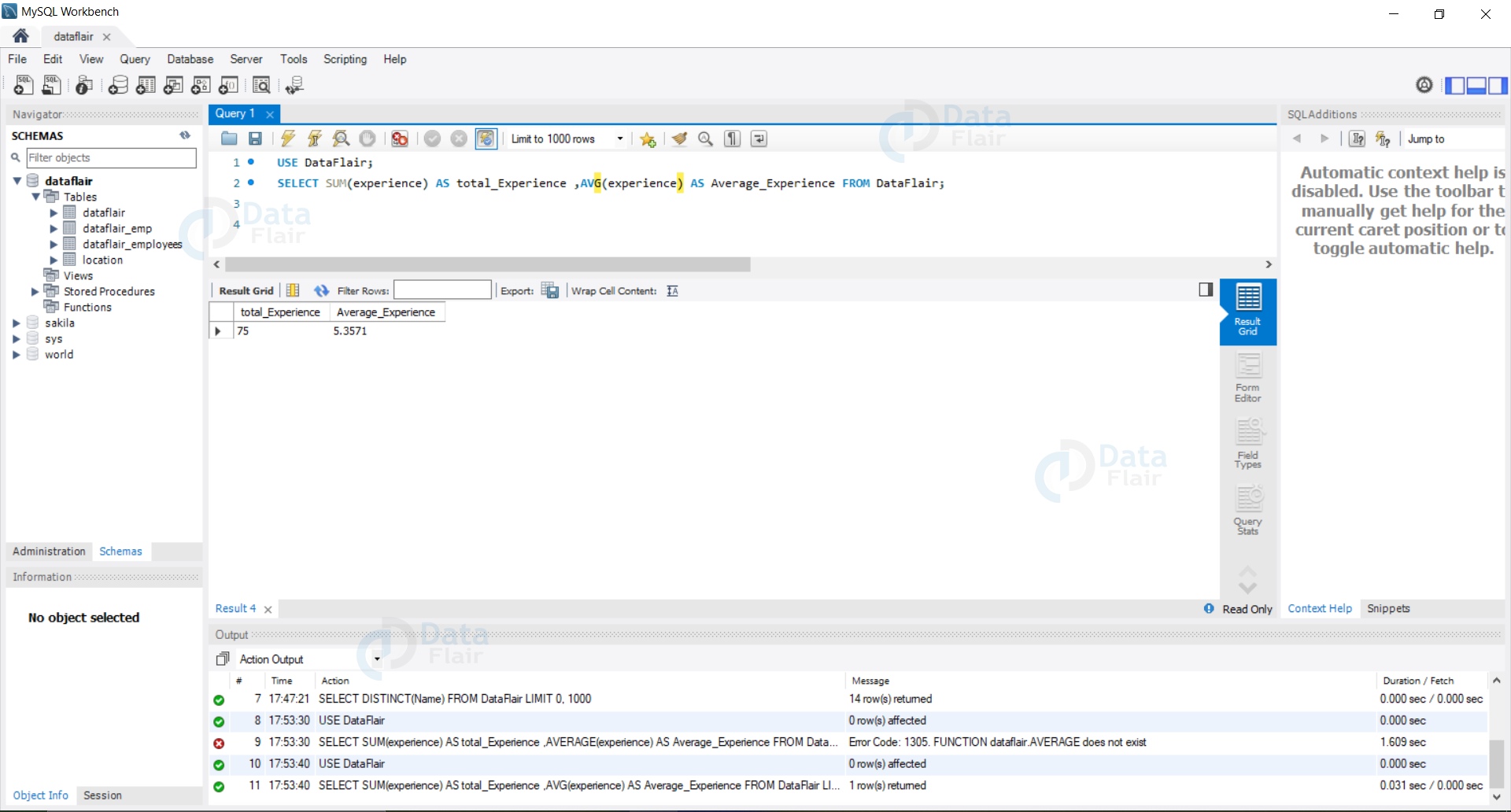Top SQL Interview Questions and Answers – Crack Your Next Interview
FREE Online Courses: Your Passport to Excellence - Start Now
In this tutorial, we will discover some of the important SQL interview questions that are frequently asked in SQL Interviews.
Do not miss to attempt these SQL Interview Questions and Answers when you apply for any SQL Job.
Let’s start!!!!
SQL Interview Questions for Beginners
Q.1. Define SQL?
SQL is the short form for Structured Query Language. We use SQL to create and manage the databases.
It provides us with various built-in functions that further help us to manage our database. We can say that SQL is a database transaction language.
It is an open-source language and is free to use with a huge developer community of its own.
Q.2. What is an RDBMS?
RDBMS stands for Relational Database Management System, it is an integral part of all the commercially functional databases.
RDBMS helps us to maintain our database. It essentially allows the ACID principles which helps us maintain the integrity of data and helps us keep our data usable for a long period.
Q.3. What are some of the uses of SQL?
Some of the uses of SQL are as follows:
- It helps us to manage the data efficiently.
- Allows us to create databases.
- Allows us to update the table by insertions and deletions of data.
- Provides us with data security and integrity.
- Compatible with almost all technologies using various packages and plugins.
Q.4. What is the full form of ACID property?
The ACID property is integral to all the commercial databases.
ACID stands or Atomicity, Consistency, Isolation and Durability.
When any database follows all these parameters, it becomes fit for any commercial application.
Q.5. What is a Query?
A query is any statement we execute using SQL as the language on our database to get the results.
The query helps us to define what data we require. In the case of SQL, we only need to specify what output we require.
The path of obtaining the result is set by the application itself in the most efficient way.
Q.6. What is the difference between a database and a table?
A database is the collection of various tables consisting of data from various resources.
Whereas a table is a single unit located inside a database which is the primary source of data storage.
In other words, we can say that a table is made up of columns and attributes while a database is made up of tables.
Q.7. What is a SELECT statement? Write the Query to get the first five records from the DataFlair table?
The SELECT statement is the primary building block of any query in SQL.
The SELECT statement is responsible for fetching the data as specified by the user under the WHERE clause.
Syntax:
SELECT col1,col2,col3,..... FROM tableName WHERE condition;
Query to find the first five records from the DataFlair database.
Query:
USE DataFlair; SELECT * FROM DataFlair LIMIT 5;
Output:
Q.8. Define the DISTINCT keyword and explain its working.
DISTINCT keyword is beneficial to find the unique records within any selected attribute by the user.
With the help of DISTINCT keyword and other aggregate functions, we can count the number of unique records in our table.
Syntax of DISTINCT keyword:
SELECT DISTINCT(col1),col2,col3,..... FROM tableName;
Let us now try to find the unique names in our DataFlair database.
Query:
USE DataFlair; SELECT DISTINCT(Name) FROM DataFlair;
Output:
Q.9. What are aggregate functions in SQL? Explain with an example.
SQL provides us with some built-in mathematical functions to perform calculations efficiently and accurately.
Some of the most popular aggregate functions in SQL are as follows:
- SUM(): Returns the sum of the numerical attributes.
- AVG(): Returns the average value of the numerical attributes.
- MAX(): Returns the max value of the numerical column.
- MIN(): Returns the minimum value of the numerical column.
- COUNT(): Returns the count of the records in any column of our table.
Let us now try to find the sum and average of the experience of employees at DataFlair to understand the aggregate functions in detail.
Query:
USE DataFlair; SELECT SUM(experience) AS total_Experience ,AVG(experience) AS Average_Experience FROM DataFlair;
Output:
Q.10. What is aliasing and why is it necessary?
Alias in SQL allows us to make the query result readable and easy to understand.
By using aliasing, we can temporarily rename the columns and the table as well to yield the result in a more presentable and readable format.
Syntax:
SELECT col1 AS alias1, col2 AS alias2, col3 ,.... FROM tableName WHERE condition;
Basic SQL Interview Questions
Q.11. What are Subqueries and what are the rules associated with them?
Subquery in SQL is also known as Nested Query, Inner query or query within a query.
In a Subquery, we nest a query in another query and consider the result produced by an inner query for running the outer query.
Subqueries come in handy when we need multiple filters on our data. With the help of subqueries, we can apply as many filters as we want.
Syntax:
SELECT * FROM (SELECT * FROM tableName WHERE condition);
Q.12. What are the different types of relationships in SQL?
We have below important relationships in SQL:
1. One-to-One
In this relationship, two tables are accessible to each other and one column of table1 can be in a relationship with a column of table 2. We can’t map more than one columns to any column of any of the tables.
2. One-to-Many & Many-to-One
This is the most common relationship in the industry, here one column of a table is related to multiple columns in the other table.
3. Many-to-Many
Here we have multiple columns of one table related to multiple tables of the second table.
4. Self Referencing Relationships
In this case, the table establishes a relationship with itself when required for use.
Q.13. What is the difference between SQL and MySQL?
SQL is the language for database transactions, which helps us to perform the CRUD operations on our tables.
While MySQL is the GUI tool for running the SQL commands and is an open-source tool. MySQL is the interface for running the SQL commands whereas, SQL is the handling language.
SQL helps us to run queries while MySQL helps us to visualize the query results adequately.
Q.14. What is a Primary Key?
A Primary key is the unique identifier data related to each row. We can have a single primary key for any table.
With the help of a Primary key, the queries can produce results efficiently saving time and CPU costs.
A Primary key can be set when we create a table or can be modified using the ALTER command and similarly can be dropped using the DROP command.
Q.15. What is a Foreign Key?
A Foreign key allows us to create a connection between two or more tables.
A table can have as many Foreign keys as required for satisfying the requirements. Foreign key help us to create a one-to-one relationship between one or more tables.
Q.16. What is the Unique keyword in SQL?
We use the unique keyword for the Primary key attribute mostly. With the help of a Unique keyword, we can ensure that the data in the respective column is non-redundant.
Also, a unique column helps us to store the identification-based columns like a contact number or mail-id’s of users.
Q.17. Define the Between clause.
In our query results sometimes we need answers to lie in a range.
When we need to specify this range in our query we use the Between clause, as otherwise, it becomes tedious.
Syntax:
SELECT col1,col2,col3,.... FROM tableName WHERE col1 BETWEEN val1 and val2;
Q.18. What are views in SQL?
Views are the temporary tables created by the user using SQL command which contains the required conditionals.
With the help of a view, we get the flexibility to decide which part of data or how many rows and columns of data we need in the newly created temporary table.
A view can contain rows and columns from one or multiple tables of the same database.
Q.19. What is a Join in SQL?
SQL join statements help us to combine the rows and columns of different tables and present them as a single collection.
When we use joins, we can easily combine and present data into a single table, which makes it easy for us to perform queries and transactions on the data which the user asks for.
We can perform joins on one or more common fields in the two or more tables.
Q.20. What are the Indexes in SQL?
Indexes are set to make the queries efficient and are accessible to the system only, i.e., Indexes are not visible to the user.
Indexes can be created using a single column or by multiple columns. We need to be cautious while creating indexes as after that updating the table becomes very difficult.
This happens because, along with the data, we need to update the indexes as well.
Q.21. What are the different Indexes available in SQL?
We use the INDEX clause to create an index in our table. The index clause helps us to query the data fast.
We have two types of indexes :
1. Implicit Indexes
When the database creates indexes on its own we call them implicit Indexes.
These are not visible to the users and are created by using the Primary key and the stated constraints while we create the table.
2. Composite Index
Composite indexes are indexes created by the user, using multiple columns as the constraint.
We use the composite index to maintain unique identification of the data points in the database.
Q.22. What is the use of Auto Increment in SQL?
In any database, we require a Primary key to identify the data stored in our database. A primary key is unique and non-redundant.
But sometimes our data has no such unique attribute. In such cases, we create a user-defined attribute and set it to auto-increment so that we can uniquely identify the data in our database.
Q.23. What is Normalization?
Normalization is the method of organizing data in the tables or databases in such a way that the data becomes functional.
We can achieve this state by creating multiple tables or by redefining the relationships between the attributes.
When a database is in the condition of normalization, the inconsistency and the redundancy is removed and kept in check thus making the database better for analysis and deployment applications.
Q.24. What do you understand by NULL values in SQL?
When we talk about the databases which are functional in the industry, many times we have a situation where some data is absent.
In such cases, we use NULL value as a placeholder to avoid any logical error in the large application.
A null value is neither equivalent to zero nor any other value. It simply means the data is not available.
Q.25. What do you understand by NOT NULL in SQL? Is it the same as NULL values?
In every database, we have a Primary key which is unique and helps us to identify each row. Thus, the primary key column can’t have any empty or missing data values.
To keep this in check we specify our primary key columns to be NOT NULL i.e they cant take null values as an entry.
No, NOT NULL is not similar to NULL values. NOT NULL is a constraint we apply on our attribute while NULL values are the placeholders for the missing data in our columns.
Summary
In this tutorial, we have discussed some of the important SQL interview questions. If you have any query related to SQL, feel free to ask in the comment section.
We work very hard to provide you quality material
Could you take 15 seconds and share your happy experience on Google




